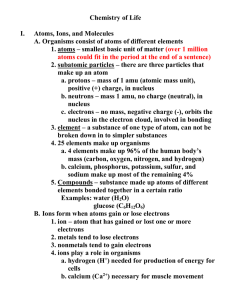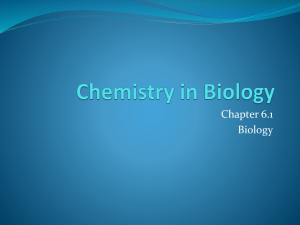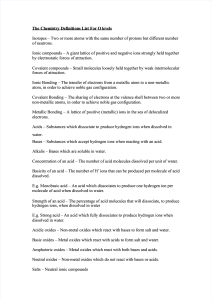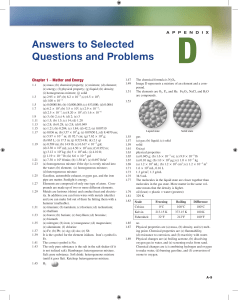Lesson Overview
advertisement
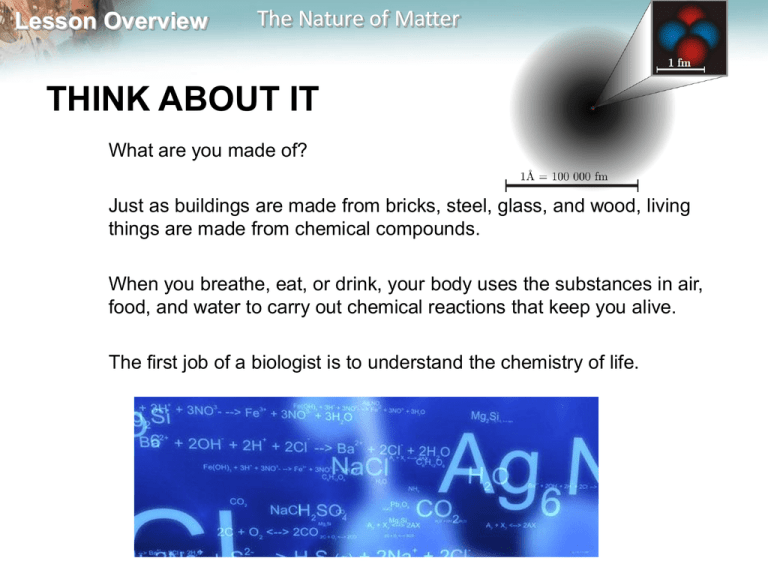
Lesson Overview The Nature of Matter THINK ABOUT IT What are you made of? Just as buildings are made from bricks, steel, glass, and wood, living things are made from chemical compounds. When you breathe, eat, or drink, your body uses the substances in air, food, and water to carry out chemical reactions that keep you alive. The first job of a biologist is to understand the chemistry of life. Lesson Overview The Nature of Matter Atoms Atoms are incredibly small. Placed side by side, 100 million atoms would make a row only about 1 centimeter long—about the width of your little finger! Despite its extremely small size, an atom contains subatomic particles that are even smaller. Lesson Overview The Nature of Matter Protons and Neutrons @Protons are positively charged particles (+) and neutrons carry no charge at all.@ Strong forces bind protons and neutrons together to form the nucleus, at the center of the atom. Lesson Overview The Nature of Matter Electrons The electron is a negatively charged particle (–) with only 1/1840 the mass of a proton. @Electrons are in constant motion in the space surrounding the nucleus.@ Lesson Overview The Nature of Matter Chemical Compounds A chemical compound is a substance formed by the chemical combination of two or more elements in definite proportions. Water, which contains two atoms of hydrogen for each atom of oxygen, has the chemical formula H2O. The formula for table salt, NaCl, indicates that the elements that make up table salt—sodium and chlorine—combine in a 1:1 ratio. Lesson Overview The Nature of Matter Chemical Compounds Sodium is a silver-colored metal that is soft enough to cut with a knife. It reacts explosively with cold water. Chlorine is a very reactive, poisonous, greenish gas that was used in battles during World War I. Sodium chloride--table salt--is a white solid that dissolves easily in water, is not poisonous, and is essential for the survival of most living things. Lesson Overview The Nature of Matter Ionic Bonds An ionic bond is formed when one or more electrons are transferred from one atom to another. Lesson Overview The Nature of Matter Ionic Bonds @Oppositely charged ions have a strong attraction for each other, forming an ionic bond.@ (Opposites attract) Lesson Overview The Nature of Matter Covalent Bonds A covalent bond forms when electrons are shared by atoms instead of being transferred. The moving electrons travel about the nuclei of both atoms Lesson Overview The Nature of Matter Polarity @A molecule in which the charges are unevenly distributed is said to be “polar” @ This is because the molecule is a bit like a magnet with two poles. The charges on a polar molecule are written in parentheses, (–) or (+), to show that they are weaker than the charges on ions such as Na+ and Cl–. Lesson Overview The Nature of Matter Hydrogen Bonding Because of their partial positive and negative charges, polar molecules such as water can attract each other. The attraction between a hydrogen atom on one water molecule and the oxygen atom on another is known as a hydrogen bond. Lesson Overview The Nature of Matter Cohesion Cohesion is an attraction between molecules of the same substance. Because a single water molecule may be involved in as many as four hydrogen bonds at the same time, water is extremely cohesive. Lesson Overview The Nature of Matter Cohesion @Cohesion causes water molecules to be drawn together, which is why drops of water form beads on a smooth surface.@ Cohesion also produces surface tension, explaining why some insects and spiders can walk on a pond’s surface. Lesson Overview The Nature of Matter Adhesion Adhesion is an attraction between molecules of different substances. @Adhesion between water and glass also causes water to rise in a narrow tube against the force of gravity.@ This effect is called capillary action Lesson Overview The Nature of Matter Heat Capacity Because of the multiple hydrogen bonds between water molecules, it takes a large amount of heat energy to cause those molecules to move faster and raise the temperature of the water. Water’s heat capacity, the amount of heat energy required to increase its temperature, is relatively high. Large bodies of water, such as oceans and lakes, can absorb large amounts of heat with only small changes in temperature. This protects organisms living within from drastic changes in temperature. At the cellular level, water absorbs the heat produced by cell processes, regulating the temperature of the cell. Lesson Overview The Nature of Matter The pH Scale Solutions with a pH below 7 are called acidic because they have more H+ ions than OH– ions. The lower the pH, the greater the acidity. Solutions with a pH above 7 are called basic because they have more OH– ions than H+ ions. The higher the pH, the more basic the solution.








